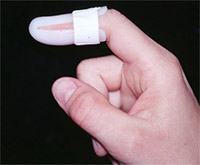When snow blowers attack: everything you need to know to avoid a snow blower injury
Are you excited for snow? Tons of it? Or perhaps just a few inches? No?
Neither are we, but every year, the snow comes and we can’t stop it. It blows, it’s cold, and it usually stays until the end of March which makes each and every one of us get out our coats, our gloves, our boots, our shovels and our snow blowers.
In light of that, here are some tips to keep your hands and fingers safe while using your snow blower.
Each year, hundreds of individuals suffer damaging injuries or amputations of their fingers or hand(s) due to improper and unsafe operating/handling of snow blowers.
Here’s what to keep in mind:
WHO is most at risk:
Most victims of the snow blower’s fury are middle-aged men. Sorry, Guys! And, those middle-aged men injure their dominant hand 90% of the time, so please be careful.
Typically, a snow blower accident results in amputation of your fingertips with the middle finger most commonly being injured.
Have we mentioned that you should be careful when using a snow blower?
WHEN do snow blowers typically attack:
There’s sort of a perfect storm of conditions, which lead to most injuries. Most injuries occur during heavy, wet snowfall of 4+ inches of snow, and these two conditions are more likely to happen if the temperature is right at or around 28 degrees.
WHY & HOW this happens:
It’s important to note that nobody just randomly decides to stick their hands into a snow blower, but when it’s cold outside and your snow blower jams up, you want to get it clear as quickly as possible.
We typically point to four things that result in snow blower injuries:
*Snow clogging the exit chute of the machine
*Not noticing that impeller blades are still rotating/engaged even though the machine is off
*Operator uses hands to attempt to clean out the clogged exit chute
*Hands make contact with rotating engaged blades, resulting in severe injury
As a last little piece of advice, you should try to remember these 9 tips when your snow blower jams:
- Turn it OFF
- Disengage clutch
- Wait at least 5 seconds after shutting machine off to let the blades to stop rotating
- ALWAYS use a broom handle or stick or handle supplied with snow blower to clear out snow
- NEVER EVER put your hand down the chute or around the blades
- Keep all protective shields in place, do NOT remove safety devices on machine
- Keep hands and feet away from all moving/engaged parts
- Avoid distractions!
- Never drink and operate machinery
Snow blowers are safe and effective when used properly!
So what happens if I do get injured?
 After your visit to the emergency room, your primary care physician will probably refer you to an orthopedic hand specialist. Not all cases require surgery, but many patients will receive a custom splint made by an occupational therapist or hand therapist.
After your visit to the emergency room, your primary care physician will probably refer you to an orthopedic hand specialist. Not all cases require surgery, but many patients will receive a custom splint made by an occupational therapist or hand therapist.
That splint is there mainly to protect your finger from further damage and to allow the finger(s) to heal.
After your finger(s) heals, you will probably return for some type of follow up therapy because of the amputation. Therapy in these situations focuses on regaining range of motion and grip strength resulting in functional use of the hand again.
Your therapist will also help to reduce scar tissue and eliminate skin hypersensitivity via a desensitization program.
More info and source for tips: AAOS
(image via)


